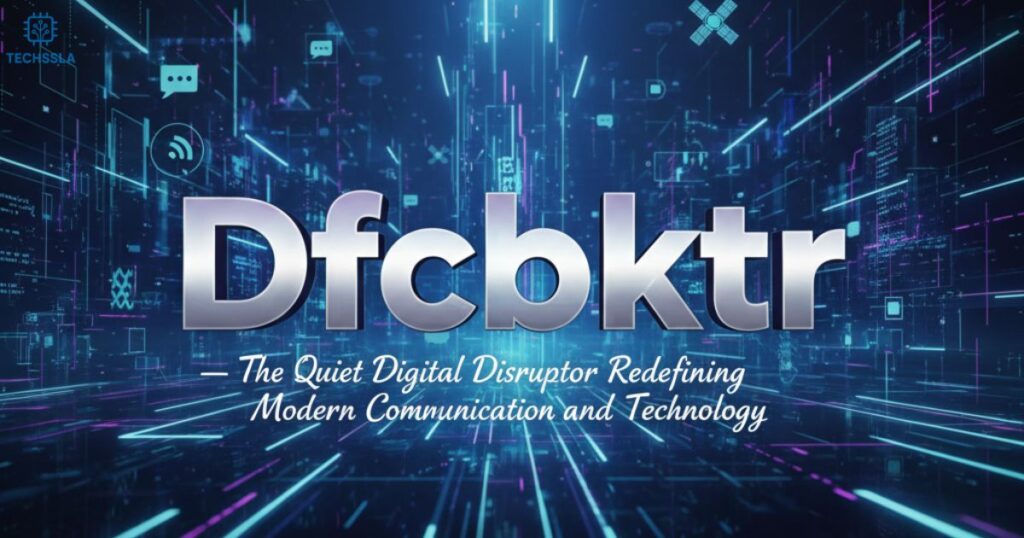Introduction — Understanding the Rise of Dfcbktr in the Digital Era
Dfcbktr: In today’s fast-paced digital landscape, how we speak, text, and connect is quietly transforming. The digital communication patterns we use online are now shaping how we express ourselves in person. This subtle but powerful shift—known as Dfcbktr—reflects the modern communication trends born from social apps, emojis, and instant replies.
People adapt their tone, rhythm, and social media language from screens to real life, creating a new linguistic blend that defines human interaction in the digital culture era. As this transformation unfolds, understanding Dfcbktr helps us appreciate how technology and language evolution work together to change how society communicates, connects, and builds meaning in everyday life.
For nore article techssla.com
What is Dfcbktr? Full Meaning, Origin, and Digital Context
The word “Dfcbktr” isn’t just a random digital code — it’s an experimental linguistic token representing how modern societies create symbols from algorithms. It mirrors the blend between emotion, code, and online conversation style, reshaping how people speak and respond in virtual spaces.
Its roots lie in AI-driven language compression, where emotional cues and semantic structures are simplified for quicker transmission. In essence, Dfcbktr is a concept illustrating the fusion between emotion, emoji culture, and the coded acronyms and slang that define Gen Z communication style and social media influence on language.
The Technology Behind Dfcbktr — How It Works
Dfcbktr functions through algorithmic compression — transforming emotional tone into data signals. AI models interpret text, emojis, and voice inflections to predict emotion. This integration relies on neurological rewiring, allowing humans to adjust naturally to this new way of communicating digitally.
The system operates on linguistic prediction models using language adaptation and digital socialization principles. These models constantly learn from human input, simulating empathy and awareness in text. The result is a powerful synthesis of context awareness, emotional expression, and communication efficiency that redefines what digital conversation feels like.
| Core Element | Function | Impact |
| Emotion Encoding | Reads tone and emoji | Builds empathy in chat |
| Semantic Mapping | Connects slang with meaning | Reduces miscommunication |
| AI Compression | Simplifies digital phrases | Boosts message speed |
Dfcbktr in Modern Communication — The Silent Influence
In today’s digital environment, Dfcbktr reshapes how people connect across platforms. It enhances text-based communication by predicting tone, meaning, and even subtle emotion. This allows messages to feel more personal, breaking the cold tone of automation.
Its quiet influence shows up in how users interpret phatic communication, the small talk that builds social bonds online. This is not just about emojis or abbreviations — it’s about authentic reaction narration, where people use digital cues to express feelings that once needed words.
Real-World Applications of Dfcbktr Across Industries
Technology companies are now adopting Dfcbktr-like systems to improve online experiences. In customer support, AI can decode tone and predict frustration before users even type the full complaint. Social apps use it to suggest more empathetic replies, increasing trust and engagement.
In education and healthcare, Dfcbktr helps professionals understand emotional tone during digital sessions. It enhances generational communication divide understanding, promoting inclusion and smoother social behavior online. This practical use strengthens both productivity and human empathy.
Cultural Impact — Dfcbktr as a Digital Symbol
Culturally, Dfcbktr represents the merging of digital culture with real-world human behavior. It mirrors how language becomes shorter, quicker, yet still deeply emotional. The digital world is now a reflection of human thought — fast, visual, and expressive.
This symbol bridges the communication gap created by screens. It demonstrates how internet-driven language can sustain human connection, reflecting modern society’s longing for shared emotion and instant feedback.
Expert Insights — What Technologists and Linguists Are Saying
Experts in modern linguistics and cognitive linguistics argue that Dfcbktr is part of a larger speech evolution process. Dr. Elaine Ford, a digital linguist at Stanford, explains, “This phenomenon marks the next chapter in how humans adapt emotionally to machines.”
Researchers studying behavioral linguistics also note its potential for improving linguistic adaptation. By balancing human feeling with algorithmic precision, Dfcbktr could become the foundation for the next era of intelligent, emotionally aware interfaces.
Challenges, Criticisms, and Ethical Considerations
Not everyone is comfortable with how Dfcbktr operates. Critics argue it encourages overreliance on digital tone detection, reducing organic emotion in online communication. Others fear privacy issues, as algorithms read private messages for emotional signals.
Ethical concerns also surround communication bias and non-verbal cues misinterpretation. Machines lack true empathy, and their readings can distort meaning, especially across cultures. The debate continues on whether digital empathy can ever equal human empathy.
The Future of Dfcbktr — Predictions for 2026 and Beyond
By 2026, Dfcbktr is expected to evolve into a universal layer of technology and language, integrated into phones, AR glasses, and social media interfaces. Imagine apps that instantly adjust tone and response based on your mood or phrasing.
Future research may focus on improving attention span in communication and boosting social empathy through adaptive emotional AI. This could transform digital chatting into something that feels genuinely human — a perfect blend of emotion, precision, and speed.
Comparison — Dfcbktr vs. Other Emerging Digital Phenomena
Unlike typical chatbot AI, Dfcbktr represents a hybrid of digital-native language and emotional simulation. It focuses less on data accuracy and more on digital-to-analog translation, bridging mechanical logic with human sentiment.
While other systems measure syntax, Dfcbktr measures soul. It leverages speech evolution and language innovation to make messages feel alive. In doing so, it transcends mere function and touches human emotion directly.
| Aspect | Dfcbktr | Traditional AI Chat |
| Focus | Emotional empathy | Data precision |
| Interaction | Adaptive tone | Static replies |
| Goal | Humanized experience | Automated response |
Conclusion — Why Dfcbktr Might Be the Next Big Shift
Dfcbktr might be the next big shift in how people interact with technology. It’s subtle yet revolutionary — blending communication psychology, digital empathy, and cultural insight into one seamless experience.
As digital life becomes the norm, Dfcbktr offers a path toward deeper, emotionally intelligent interaction. It’s not just a buzzword; it’s the language of tomorrow — built on empathy, awareness, and the eternal human desire to connect.
FAQs About Dfcbktr
1. What is Dfcbktr, and how does it affect communication?
Dfcbktr is a digital phenomenon blending AI and human emotion, reshaping how people express tone, empathy, and meaning in digital communication.
2. How does digital culture change face-to-face language?
Digital culture shortens phrases, adds emoji-driven emotion, and alters tone, influencing real-world conversation styles and gestures.
3. Examples of Dfcbktr in real life?
Voice assistants, predictive texting, and emotionally aware chatbots reflect Dfcbktr in action — merging emotion with technology.
4. How do emojis and acronyms affect human speech?
They compress meaning, allowing faster emotional exchange, but can also reduce verbal depth and clarity in modern communication.
5. Why do people use digital slang in real conversations?
It signals identity, humor, and belonging within online communities, blending social media language with real-life talk.
6. Impact of social media on spoken language?
Social media reshapes speech rhythms, tone, and vocabulary, spreading acronyms and slang into daily conversation.
7. Pros and cons of digital communication habits?
They enhance global connection and communication efficiency, but may weaken empathy and attention during face-to-face communication.
8. Understanding De-Facebooking Translation?
It’s the shift from oversharing online to reclaiming privacy, redefining how people present their digital identity.
9. Language changes in the age of technology?
Technology accelerates language evolution, making speech more visual, adaptive, and data-driven through emojis and short text.
10. Communication differences between generations?
Older groups prefer direct talk, while Gen Z communication style favors symbols, memes, and emotional brevity.
11. How is Gen Z language changing workplaces?
Gen Z introduces informal tone, emoji use, and quick replies, challenging traditional communication etiquette.
12. How to balance digital and personal communication?
By setting screen limits, prioritizing calls or meetings, and nurturing genuine emotional presence in conversations.
13. How to avoid miscommunication in the digital age?
Use clear tone indicators, double-check intent, and understand context awareness before sending digital messages.
14. What causes Dfcbktr behavior?
It’s driven by digital socialization, fast-paced messaging habits, and reliance on emotional AI translation.
15. Is Dfcbktr good or bad for society?
Both — it enhances connection and expression but risks emotional dilution and communication bias if overused.
16: Is Dfcbktr a real technology or concept?
Dfcbktr is both a conceptual framework and an evolving digital system that reshapes online vs offline speech and fosters smarter, more emotional interaction.
17: How does it affect communication?
It improves verbal acronyms, emoji translation, and overall empathy across platforms by enhancing emotional tone.
18: Can Dfcbktr change real-life communication?
Yes, it influences social media’s effect on speech and cultural communication shift, narrowing the space between virtual and face-to-face communication.
19: Why is Dfcbktr important for a tech-driven society?
Because it strengthens tech-driven society awareness, digital literacy, and social literacy, and enhances modern communication etiquette for the next era of human connection.



